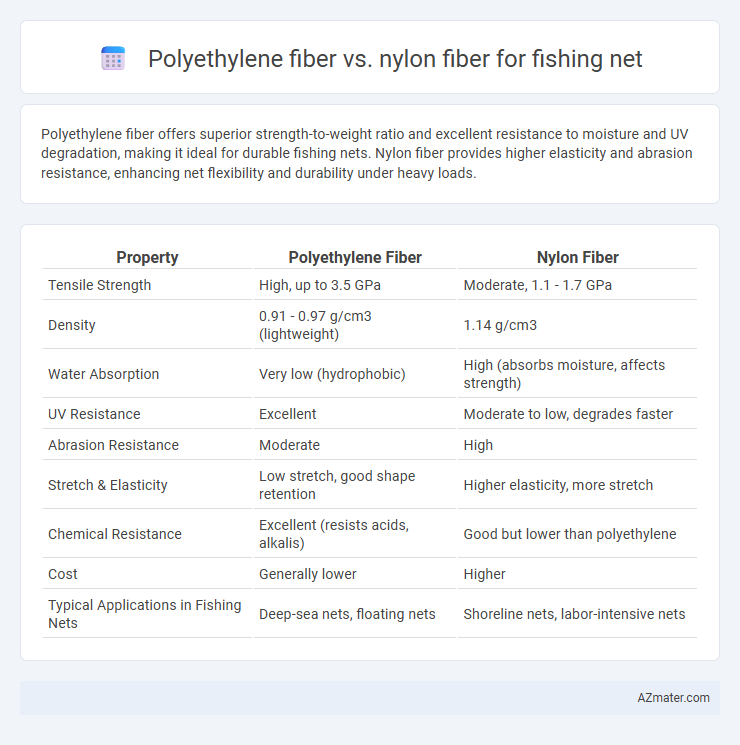Polyethylene fiber offers superior strength-to-weight ratio and excellent resistance to moisture and UV degradation, making it ideal for durable fishing nets. Nylon fiber provides higher elasticity and abrasion resistance, enhancing net flexibility and durability under heavy loads.
Table of Comparison
| Property | Polyethylene Fiber | Nylon Fiber |
|---|---|---|
| Tensile Strength | High, up to 3.5 GPa | Moderate, 1.1 - 1.7 GPa |
| Density | 0.91 - 0.97 g/cm3 (lightweight) | 1.14 g/cm3 |
| Water Absorption | Very low (hydrophobic) | High (absorbs moisture, affects strength) |
| UV Resistance | Excellent | Moderate to low, degrades faster |
| Abrasion Resistance | Moderate | High |
| Stretch & Elasticity | Low stretch, good shape retention | Higher elasticity, more stretch |
| Chemical Resistance | Excellent (resists acids, alkalis) | Good but lower than polyethylene |
| Cost | Generally lower | Higher |
| Typical Applications in Fishing Nets | Deep-sea nets, floating nets | Shoreline nets, labor-intensive nets |
Introduction: Polyethylene vs Nylon in Fishing Nets
Polyethylene fiber offers exceptional strength-to-weight ratio and superior resistance to water absorption, making it highly durable for fishing nets exposed to harsh marine environments. Nylon fiber provides excellent elasticity and abrasion resistance, enhancing net flexibility and preventing breakage under tension. Selecting between polyethylene and nylon fibers depends on the specific fishing conditions, with polyethylene favored for longevity and lightness, while nylon excels in stretchability and impact resilience.
Material Composition and Properties
Polyethylene fiber, made from high-density polyethylene (HDPE), is favored for fishing nets due to its exceptional chemical resistance, low water absorption, and high tensile strength, making it lightweight and durable in marine environments. Nylon fiber, composed of polyamide polymers, offers superior elasticity, abrasion resistance, and shock absorption, which enhances the net's flexibility and longevity under dynamic stresses. The choice between polyethylene and nylon fibers depends on specific fishing needs, with polyethylene excelling in harsh saltwater conditions and nylon providing better stretch and impact resistance.
Strength and Durability Comparison
Polyethylene fiber offers superior tensile strength and excellent resistance to abrasion, making it highly durable for fishing nets exposed to harsh marine environments. Nylon fiber provides strong elasticity and impact resistance, allowing fishing nets to absorb sudden loads without breaking, but it is more prone to UV degradation over time. Overall, polyethylene nets typically outperform nylon in long-term strength retention and durability under constant water exposure and rough handling.
Weight and Flexibility Differences
Polyethylene fiber used in fishing nets offers lightweight properties, often weighing significantly less than nylon fiber, which enhances ease of handling and reduces fatigue during prolonged use. Nylon fiber provides superior flexibility, allowing the net to stretch without breaking and increasing durability under dynamic aquatic conditions. The choice between polyethylene and nylon depends on the balance needed between lightweight performance and flexible strength for specific fishing applications.
Abrasion and UV Resistance
Polyethylene fiber fishing nets exhibit superior abrasion resistance due to their high tensile strength and low friction surface, making them ideal for rugged aquatic environments. Nylon fibers, while moderately abrasion-resistant, tend to degrade faster under prolonged UV exposure, reducing their lifespan in sunlight-intensive settings. Polyethylene's excellent UV resistance preserves net integrity over time, enhancing durability and performance in harsh outdoor conditions.
Water Absorption and Maintenance
Polyethylene fiber exhibits extremely low water absorption, making it highly resistant to waterlogging and maintaining its strength and durability in wet conditions, which reduces maintenance needs for fishing nets. Nylon fiber absorbs more water, leading to increased weight, slower drying times, and potential weakening over time, necessitating more frequent inspections and repairs. Polyethylene nets require less frequent maintenance due to their moisture-resistant properties, resulting in longer service life and better performance in aquatic environments.
Cost Efficiency and Longevity
Polyethylene fiber offers superior cost efficiency for fishing nets due to its lower raw material price and reduced maintenance needs compared to nylon fiber. Polyethylene's high resistance to water absorption and UV degradation extends net longevity, minimizing replacement frequency and associated operational costs. Nylon fiber, while strong and flexible, tends to absorb water and is more prone to degradation, leading to higher long-term expenses despite initial performance benefits.
Environmental Impact and Recyclability
Polyethylene fiber used in fishing nets is highly resistant to water absorption and chemicals, making it more durable but slower to degrade in marine environments, contributing to long-term environmental pollution. Nylon fiber, while also strong and durable, tends to biodegrade faster than polyethylene but can release harmful nitrogen-based compounds during degradation. Both fibers are recyclable, yet polyethylene recycling typically requires less energy and results in fewer emissions compared to nylon, positioning polyethylene as a slightly more eco-friendly option for sustainable fishing net production.
Application Suitability in Different Waters
Polyethylene fiber offers superior buoyancy and excellent resistance to saltwater corrosion, making it ideal for fishing nets used in marine and brackish waters. Nylon fiber provides higher elasticity and strength, which enhances durability and abrasion resistance, suitable for freshwater fishing environments with rocky or rough substrates. Choice between polyethylene and nylon fibers depends on water type, with polyethylene preferred for saltwater applications and nylon favored in freshwater conditions.
Choosing the Right Fiber for Your Fishing Needs
Polyethylene fiber offers exceptional abrasion resistance and low water absorption, making it ideal for saltwater fishing nets that require durability and buoyancy. Nylon fiber provides superior elasticity and strength, which enhances knot retention and shock absorption, suitable for heavy-duty freshwater and deep-sea fishing applications. Selecting the right fiber depends on your fishing environment and target species, balancing factors like strength, stretch, and resistance to UV degradation.

Infographic: Polyethylene fiber vs Nylon fiber for Fishing net
 azmater.com
azmater.com